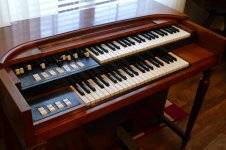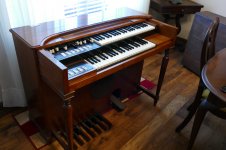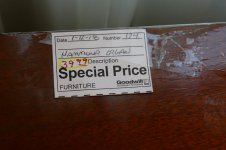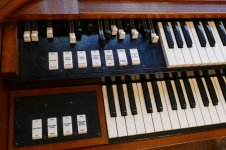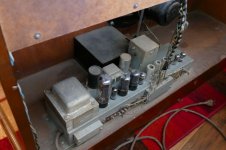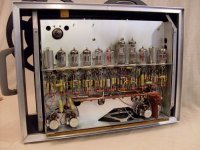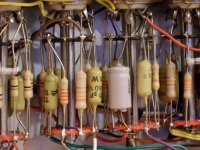Power supplies and support circuitry on PCBs with the audio P-T-P does seem to be quite common.
Sorry, but I can spot several things that would rate this gear only second best or mediocre.
From the top, this is as far away as the earth from the moon.
And PTP-wiring alone doesn't make for top gear equipment.
Btw, all point to point are just glued connections here, pretty bad. It should be "wrap before solder" standard to be excellent, of course.
The parts I can spot are just the ordinary, cheap quality asian parts. Amounts of money spend for those is nearly worth nothing. Thats why they are being used so massive. They are cheap, cheap and cheap.
With that, you will never end in the high end domain. You can dream about that like so many others, but your as far aways as those daydreamers are.
For the top end, go to companies no longer exist and their names you may have never heard of. And you'll be short of cash, soon. Because the best is always rare as hens teeth and the sport of the kings to hunt for. And that means very deep pockets. No cheap asian parts are asked here.
The best parts you can go hunting after and every single one of it would cost you more than this whole amp.
But its point to point wiring in some sections, thats a fact.
From the top, this is as far away as the earth from the moon.
And PTP-wiring alone doesn't make for top gear equipment.
Btw, all point to point are just glued connections here, pretty bad. It should be "wrap before solder" standard to be excellent, of course.
The parts I can spot are just the ordinary, cheap quality asian parts. Amounts of money spend for those is nearly worth nothing. Thats why they are being used so massive. They are cheap, cheap and cheap.
With that, you will never end in the high end domain. You can dream about that like so many others, but your as far aways as those daydreamers are.
For the top end, go to companies no longer exist and their names you may have never heard of. And you'll be short of cash, soon. Because the best is always rare as hens teeth and the sport of the kings to hunt for. And that means very deep pockets. No cheap asian parts are asked here.
The best parts you can go hunting after and every single one of it would cost you more than this whole amp.
But its point to point wiring in some sections, thats a fact.
Last edited:
Can you say electronic organ?
Nice, I see 12 oscillators, probably divided down to cover all the octaves?
Yes, that's it!
Btw, I've won a 1 € bid on a Hammond S-6 chord organ some years ago I don't really have use for. It's got 36 freely running oscillators (featuring 18 12AU7's) and, of course, a PSU and a power amp - each in their own chassis. And all PTP wired 😉.
Best regards!
Btw, I've won a 1 € bid on a Hammond S-6 chord organ some years ago I don't really have use for. It's got 36 freely running oscillators (featuring 18 12AU7's) and, of course, a PSU and a power amp - each in their own chassis. And all PTP wired 😉.
Best regards!
I assume. I'm not an authority by any means. It was a Lowery with a basket of 6X8's in it. I still have the power amp/supply intact.
My thoughts were to finds its twin and build a set of mono blocks just to see how the output transformers sounded.
The output used 6L6's if I recall.
My thoughts were to finds its twin and build a set of mono blocks just to see how the output transformers sounded.
The output used 6L6's if I recall.
For the top end, go to companies no longer exist and their names you may have never heard of. And you'll be short of cash, soon. Because the best is always rare as hens teeth and the sport of the kings to hunt for. And that means very deep pockets..... The best parts you can go hunting after and every single one of it would cost you more than this whole amp.
I'll make do with parts from well known suppliers at reasonable prices rather than chasing fools gold. 😀
If you build with reknown suppliers brand parts of good quality, than you've done much more compared to the parts shown in this bespoken example.
But I assume, you don't know the suppliers I mentioned. So you are writing on a topic you are not experienced with, neither have heard those brand names.
Go on, writing about things you don't know and which you have never heard of. Maybe it will give you pleace of mind, because thats what most people are searching for with the mantra that others are only foolish behaviour and they are doing the most rationalistic thing in life. Life itself has many pleasures to offer. Some of them aren't rationalistic at all, but they spend joy to those who can afford it. You are more the rationalistic type of person, so stay where you are, keep doing what you do. And keep that daily routine repeating the mantra of the fool on the hill. It will give you peace of mind.
But I assume, you don't know the suppliers I mentioned. So you are writing on a topic you are not experienced with, neither have heard those brand names.
Go on, writing about things you don't know and which you have never heard of. Maybe it will give you pleace of mind, because thats what most people are searching for with the mantra that others are only foolish behaviour and they are doing the most rationalistic thing in life. Life itself has many pleasures to offer. Some of them aren't rationalistic at all, but they spend joy to those who can afford it. You are more the rationalistic type of person, so stay where you are, keep doing what you do. And keep that daily routine repeating the mantra of the fool on the hill. It will give you peace of mind.
I assume. I'm not an authority by any means. It was a Lowery with a basket of 6X8's in it. I still have the power amp/supply intact.
My thoughts were to finds its twin and build a set of mono blocks just to see how the output transformers sounded.
The output used 6L6's if I recall.
Yes, that's it!
Btw, I've won a 1 € bid on a Hammond S-6 chord organ some years ago I don't really have use for. It's got 36 freely running oscillators (featuring 18 12AU7's) and, of course, a PSU and a power amp - each in their own chassis. And all PTP wired 😉.
Best regards!
When I was about 13 a cousin of mine was given a big tube-based organ to take apart (this was late-60's). We both liked to take stuff apart. It had 1st generation PC boards one for each oscillator, as I recall 4 tubes on each board. And it had a lot of boards, not just the top octave 12 tone. I would imagine the pedals had their own dedicated 12 oscillators. And the upper and lower ranks added another 24 boards. Each dividing down the width octaves, not to mention all the timbre circuitry. Wish I could take a look at that stuff again. He gave me a few of the boards, fun stuff.
This ↑ reminds me of a Hammond Concorde that I parted out last summer. About fifty individual PCB's, a harness of multiple looms among them, but no tubes, just IC's and transistors. I didn't manage to get the instrument functional again, due to warped phenolic (!) boards and the resulting contact issues.
I saved the manuals, the drawbar sets, the pedal keys with it's switch unit and the speakers, including the Leslie unit (a Rotosphere actually), for an upcoming Hammond clone build.
Best regards!
I saved the manuals, the drawbar sets, the pedal keys with it's switch unit and the speakers, including the Leslie unit (a Rotosphere actually), for an upcoming Hammond clone build.
Best regards!
I began my electronics journey as a kid in the early 60's digging through the trash dump to rip parts from discarded TV's radios and HiFi sets. Everything was outside in the Florida heat and humidity, so things like speakers and transformers needed to be harvested right after arrival. Organs were not common in the landfill, but I did rob the tubes and speakers from one or two.
I rebuilt an old Baldwin organ in high school. It was all PTP wired and used 36 6SN7 tubes in the tone generator. Leaky bumble bee caps were the biggest problem. Many had cracked from the heat. There were two power transformers in the main chassis. The big one was just for the tube heaters. The fat green wires went to a pair of bus bars that ran the width of the organ.
I would tinker with musical keyboards off and on for much of my life, but that old Baldwin was the last of the PTP wired tube stuff.......
Until a chance wandering through a thrift store stopped me in my tracks.....How often do you find a 1958 vintage Hammond M3 tonewheel organ being sold for $39.99? The manager said that it was being sold as a piece of furniture, and the power cord was cut off to prevent it from being powered up. I left a deposit and came back the next day in the snow storm with a van.
The big dude that helped me stuff it in the van showed me the power cord and told me that he couldn't bear to cut it off. The organ worked perfectly and his friends played it several times after the boss had left for the day. It does work nice.
Back in my teenage years I made a "Leslie speaker" out of a large paint can, a turntable, a guitar speaker, and some wood. I used it with a electric guitar, so no horns were needed. I can see a modern version of that in my future.
I rebuilt an old Baldwin organ in high school. It was all PTP wired and used 36 6SN7 tubes in the tone generator. Leaky bumble bee caps were the biggest problem. Many had cracked from the heat. There were two power transformers in the main chassis. The big one was just for the tube heaters. The fat green wires went to a pair of bus bars that ran the width of the organ.
I would tinker with musical keyboards off and on for much of my life, but that old Baldwin was the last of the PTP wired tube stuff.......
Until a chance wandering through a thrift store stopped me in my tracks.....How often do you find a 1958 vintage Hammond M3 tonewheel organ being sold for $39.99? The manager said that it was being sold as a piece of furniture, and the power cord was cut off to prevent it from being powered up. I left a deposit and came back the next day in the snow storm with a van.
The big dude that helped me stuff it in the van showed me the power cord and told me that he couldn't bear to cut it off. The organ worked perfectly and his friends played it several times after the boss had left for the day. It does work nice.
Back in my teenage years I made a "Leslie speaker" out of a large paint can, a turntable, a guitar speaker, and some wood. I used it with a electric guitar, so no horns were needed. I can see a modern version of that in my future.
Attachments
Nice find! The current panwhatzit situation has seriously cut down on my access to the thrift stores swap meets and hamfests. Wife is taking it surprisingly well?
That is beautiful.Here's a view into one of a pair of Circlotron monophonic amplifiers, featuring PL519's, that I built in 2001. As I don't have the file anymore, I had to borrow the picture from another site:
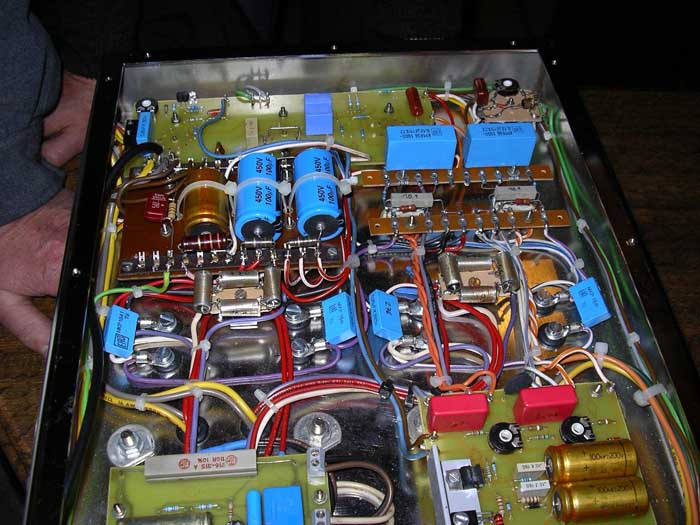
It's a hybrid construction. Inrush current limiter, bias supply and small signal tubes are on PCB's, while the main PSU, the power tubes and the VU indicator are wired PTP.
Best regards!
So your saying you want to build your new unit with "classic" point to point wiring, be careful what you wish for....
Harmon Kardon TA-7000A receiver...
--------------------------------------------------------------------
Man, that is wild.This has possibly been here already, nothing I could claim the glory for, but I‘ll tell ya when I’m there!

Those where very convinient, can you still buy them somewhere?Another variation on point-to-point.
Here is my attempted point to point



 with a phono-stage. And yes, I used solder as glue.
with a phono-stage. And yes, I used solder as glue.
Try Surplus Sales of Nebraska and RF Parts. They list some but are pretty expensive.Those where very convinient, can you still buy them somewhere?
Tnx for letting me know, i will check em out.Try Surplus Sales of Nebraska and RF Parts. They list some but are pretty expensive.
- Home
- Amplifiers
- Tubes / Valves
- Point to point wiring
